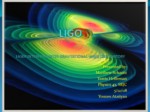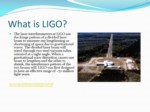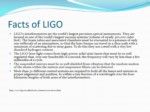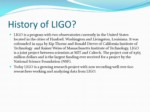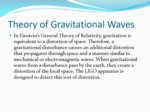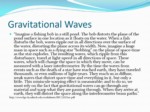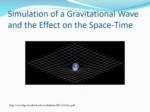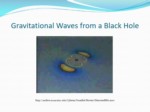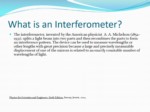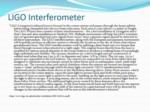بخشی از پاورپوینت
--- پاورپوینت شامل تصاویر میباشد ----
اسلاید 1 :
What is LIGO?
The laser interferometers at LIGO use the fringe pattern of a divided laser beam to measure any lengthening or shortening of space due to gravitational waves. The divided laser beam will travel through two steel vacuum tubes oriented at a right angle. When a gravitational wave distortion causes one beam to lengthen and the other to shrink, the interference pattern of the two beams will. LIGO was first designed to have an effective range of ~70 million light years.
http://www.ligo-la.caltech.edu/worksheets/SEC/LIGO101.pdf
http://www.phys.lsu.edu/lsusps/zonemeeting2007/LIGO.gif
اسلاید 2 :
Facts of LIGO
LIGO's interferometers are the world's largest precision optical instruments. They are housed in one of the world's largest vacuum systems (volume of nearly 300,000 cubic feet). The beam tubes and associated chambers must be evacuated to a pressure of only one-trillionth of an atmosphere, so that the laser beams can travel in a clear path with a minimum of scattering due to stray gases. To do this they use a steel with a very low dissolved hydrogen content.
The LIGO laser light comes from high-power, solid-state lasers that must be so well regulated that, over one hundredth of a second, the frequency will vary by less than a few millionths of a cycle.
The suspended mirrors must be so well shielded from vibration that the random motion of the atoms within the mirrors and suspension fibers can be detected.
More than 30 different control systems are required to hold all the lasers and mirrors in proper alignment and position, to within a tiny fraction of a wavelength over the four-kilometer lengths of both arms of the interferometers.
http://www.ligo-la.caltech.edu/contents/overviewsci.htm
اسلاید 3 :
History of LIGO?
LIGO is a program with two observatories currently in the United States located in the cities of Hanford, Washington and Livingston, Louisiana. It was cofounded in 1992 by Kip Thorne and Ronald Drever of California Institute of Technology and Rainer Weiss of Massachusetts Institute of Technology, LIGO is a joint project between scientists at MIT and Caltech. The project cost of $365 million dollars and is the largest funding ever received for a project by the National Science Foundation (NSF).
Today LIGO is a growing research project with now recording well over 600 researchers working and analyzing data from LIGO.
اسلاید 4 :
Theory of Gravitational Waves
In Einstein’s General Theory of Relativity, gravitation is equivalent to a distortion of space. Therefore, a gravitational disturbance causes an additional distortion that propagates through space and a manner similar to mechanical or electromagnetic waves. When gravitational waves from a disturbance pass by the earth, they create a distortion of the local space. The LIGO apparatus is designed to detect this sort of distortion.
اسلاید 5 :
Gravitational Waves
“Imagine a fishing bob in a still pond. The bob distorts the plane of the pond surface in one location as it floats on the water. When a fish disturbs the bob, waves ripple out in all directions over the surface of the water, distorting the plane across its width. Now, imagine a huge mass in space such as a dying star “bobbing” on the plane of space-time as the star explodes. The resulting waves, which ripple from this disturbance, travel at light-speed in all directions of space. These waves, which will change the space in which they move, can be measured with a laser interferometer. By the time the waves from events such as the death of a star have reached earth, they have traveled thousands, or even millions of light-years. They reach us as diffuse, weak waves that distort space-time and everything in it, but only a little. This miniscule warping effect is measurable; and to do so, we must rely on the fact that gravitational waves can go through any material and warp what they are passing through. When they arrive at earth, they will distort the space along the interferometer beam paths.”
http://www.ligo-la.caltech.edu/worksheets/SEC/LIGO101.pdf
اسلاید 6 :
What is an Interferometer?
The interferometer, invented by the American physicist A. A. Michelson (1852–1931), splits a light beam into two parts and then recombines the parts to form an interference pattern. The device can be used to measure wavelengths or other lengths with great precision because a large and precisely measurable displacement of one of the mirrors is related to an exactly countable number of wavelengths of light.
Physics for Scientists and Engineers, Sixth Edition, Serway, Jewett, 2004
اسلاید 7 :
LIGO Interferometer
“LIGO Livingston’s infrared laser is housed in the corner station and passes through the beam splitter before being channeled into the two beam tube arms. Each arm is 4 km (about 2.5 miles) in length. The LIGO Project thus consists of three interferometers – the 4 km installation at Livingston and a dual 2 km and 4km installation at Hanford, WA. Multiple instruments will help the LIGO scientists sort out genuine gravitational wave signals from ‘noise’, since a genuine signal should be detected in all three instruments. The LIGO interferometers, along with the European and Japanese instruments will hopefully produce an effective system to identify the locations in the sky of events that release gravitational waves. The LIGO interferometers work by splitting a laser beam into two beams that travel through vacuum tubes situated at a right angle. The original beam directly from the laser is modified by various optical elements in the corner station to produce a working beam of exceedingly high uniformity and stability. The vacuum chambers are 4 km in length and are constructed of welded steel tubes that are 1.3m (4 ft.) in diameter and 3mm. (1/8 in.) thick. The 250 mm. (10 in.) mirrors are suspended at the end stations. The mirrors are suspended on wires from tables that are designed to eliminate any movement caused by other forces such as earthquakes, wind, earth tidal motion, etc. The vacuum tubes and optical chambers where the mirrors are housed are designed to create a “clean” pathway through which the laser light can travel. LIGO’s interferometers have additional mirrors besides those shown in the Michelson drawing above. Fabry-Perot mirrors, which are located in the corner station, cause the laser light to bounce back and forth within each arm a number of times as more light is added to the arms, building up the light power in each arm before the light is able to escape. A recycling mirror, also in the corner station, sends returned light back to these Fabry-Perot cavities. The additional light power created by these features allows the interferometer to detect weaker signals. As the laser beam travels back and forth between the mirrors up to 100 times in a millisecond, any shift of the mirrors by a gravitational wave will be detected by changes in the interference pattern that will be seen at the interferometer’s detector.”
http://www.ligo-la.caltech.edu/worksheets/SEC/LIGO101.pdf
اسلاید 8 :
LIGO’S OBJECTIVE
The LIGO mission (or objective) is to observe gravitational waves of cosmic origin. Here are some of the possible sources of gravitational radiation or waves:
♦ The supernova collapse of stellar cores to form neutron stars or black holes
♦ The collisions and coalescences of neutron stars or black holes
♦ The wobbly rotation of neutron stars with deformed crusts
♦ The remains of radiation (gravitational) created in the early universe
اسلاید 9 :
The Future of LIGO
Despite LIGO being very young, they have already begun in advancements of LIGO, recently there was more funding granted to LIGO ($205 million dollars) to expand and improve upon LIGO creating:
LIGO ADVANCED (LIGO 2)
This improvement should increase the accuracy considerably and bandwidth of the interferometer and allow for much greater possibilities in the future of its research.
LIGO 2 should be completed in the year 2014.
اسلاید 10 :
LISA (Laser Interferometer Space Antenna)
LISA, the Laser Interferometer Space Antenna, is a proposed joint project of NASA and the European Space Agency to build a laser interferometer gravitational wave detector consisting of three spacecraft in solar orbit. LISA will receive different types of readings than LIGO(LISA receives the readings in higher frequency than LIGO), so the two experiments will complement each other.

